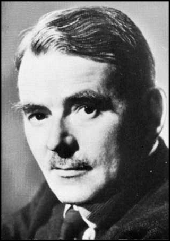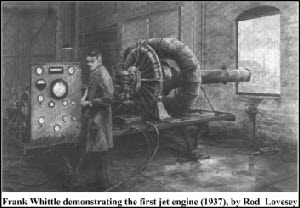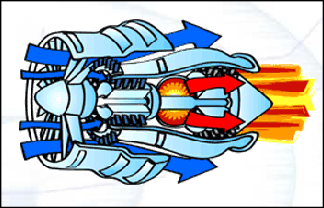




12th November 2010
Engineers & Engineering
Whittle was born in Coventry and after joining the Royal Air Force at 16 and developing a knowledge of aircraft and flying he became a test pilot in 1937. He studied Mechanical science at Peterhouse College, Cambridge for which he was awarded a First Class degree and at the age of 22 began to explore using gas turbines as a propulsion system for aircraft flying at altitudes too high for piston-engined - propeller driven aircraft to operate,
His thesis in 1928 was entitled Future Developments in Aircraft Design.
He sought private funding support for his development after being turned down by the Air Ministry and Whittle patented his jet engine in 1930. His
He sought private funding support for his development after being turned down by the Air Ministry and Whittle patented his jet engine in 1930. His
‘secret engine’, since the war affected many such developments - first flew in 1941. The American General Electric XP-59A flew in October 1942 with the Uk’s Gloster Meteor flying in 1944.
With private financial support, he began construction of his first engine in 1935. This engine, which had a single-stage centrifugal compressor coupled to a single-stage turbine, was successfully bench tested in April 1937.


1907 - 1996

Sir Frank Whittle is sometimes credited as being the greatest aero-engineer of the 20th century since through his ingenuity and endeavours Britain was the first to enter the jet age., The first true jet plane - the Gloster-Whittle plane flew successfully from Cranwell, piloted by Gerry Sayer and achieved a speed of 370 mph - faster than any other conventional propeller-driven machine. From those early beginnings modern air transport began and we now have the situation where around 65 billion person-airmiles are flown annually by US airlines alone ! It is alarming to think that Whittle received very little financial gain from his invention since his company was taken over by the British Government - nationalised effectively. Whittle had preferred thjis course of action to one in which foreign governments might have taken over the company and it was only in the late 1940s when he received a payment of £100,000 . (£2.4 million - 2007 values ... approx $ 4 million )
The workings of the gas turbine - and indeed the other variants of turboprops, turbofans,
ramjets, etc are explained in detail on other sites but the principle of Whittle’s idea is based on compressing air into the body of the engine by a series of rotating fans - this moving air is then mixed with fuel and ignited - and this additional compression accelerates even more the already fast moving airflow. This also drives the compressor and at high temperatures the flow of hot gases has such a significant thrust that the engine is propelled forwards. It is hardly surprising that some of Whittle’s earliest trials saw the engine moving out of control !


